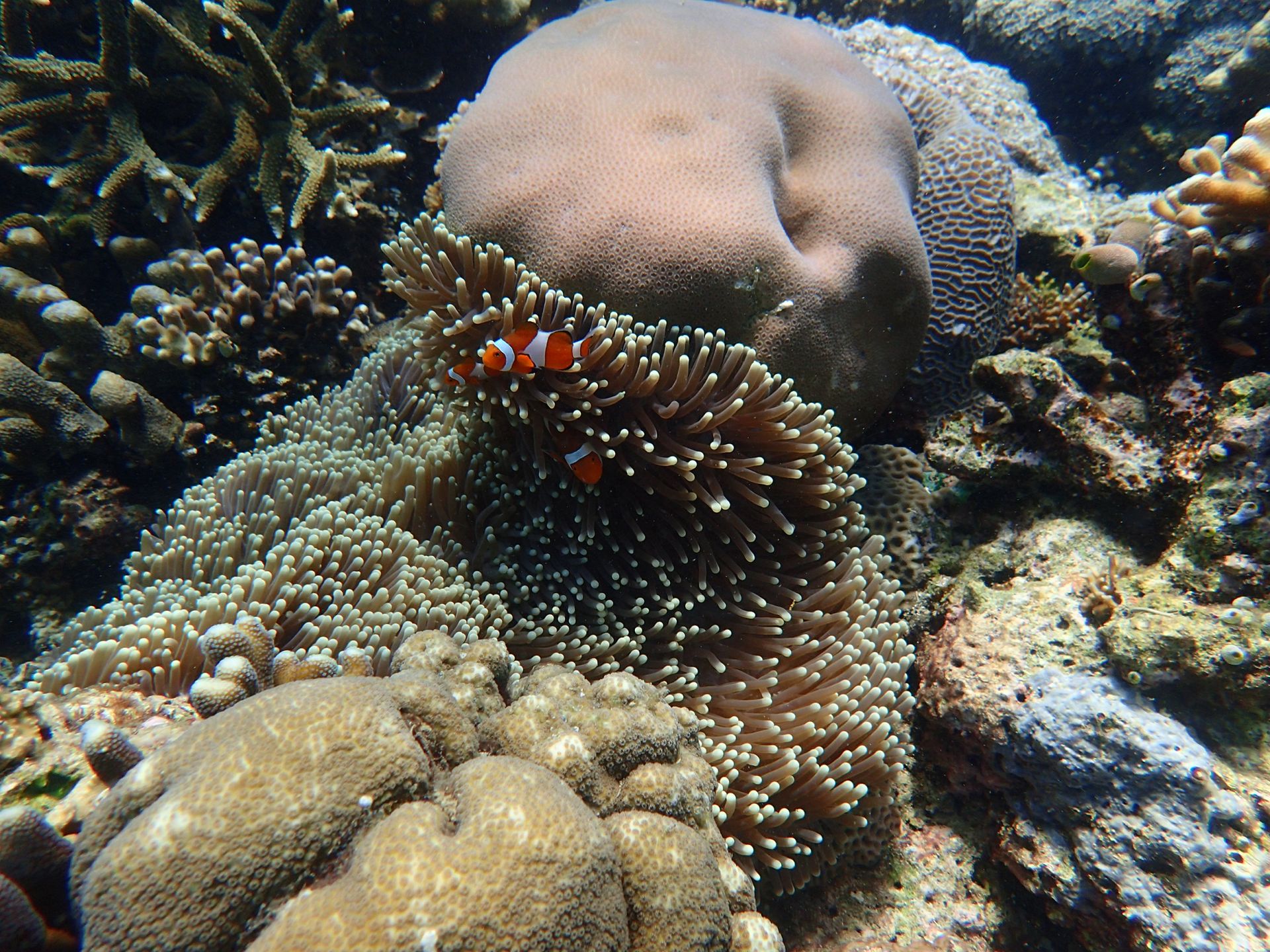Blog by 4D-Reef ESRs Mariya Perepelytsya, based at Deltares (the Netherlands), and Kathrine Maxwell, based at Leibniz Center for Tropical Marine Research (Germany).
Last 17 to 29 October 2022, the 4D-REEF Team went to Indonesia for the fifth Networking and Training Activity (NTA) after almost 2.5 years of waiting. It was two weeks of, well, networking and training activities, with the ESRs and our Indonesian colleagues. We spent our first week in Makassar in South Sulawesi and our second week in Denpasar in Bali, visiting the island communities, snorkeling on the reefs, learning from local experts, and seeing the marine conservation efforts in the region along with enjoying the Indonesian culture and, most especially, good food. It was generally a memorable experience for the ESRs as we have gotten closer and learned useful information, especially now that the program comes to its fruition. As we were also joined by our Indonesian colleagues, some of us even got closer to our Indonesian friends (and some had the chance to meet new ones). We thought of sharing with you a glimpse of some of the memorable experiences we had during the NTA – the activities, the reefs, and the tasty food and good company.
Week 1 in Makassar
Sunday – Day 0
Mariya
After 38 hours on the go I was finally rewarded with a luxury of a hot shower and a comfortable bed. Not a lot of sleep, as in the morning I had to rush for a tasty breakfast and enjoying the view of the sea from my window. After meeting most of the 4D-REEF team and having coffee for some functioning, I joined a part of the team in discovering our surroundings. We visited the Fort of Rotterdam, all that effort and long way, and yet I am back to Rotterdam again!
In the evening most of us arrived in Makassar, so it was time for a group dinner, live music and trying the first Indonesian cuisine dishes.
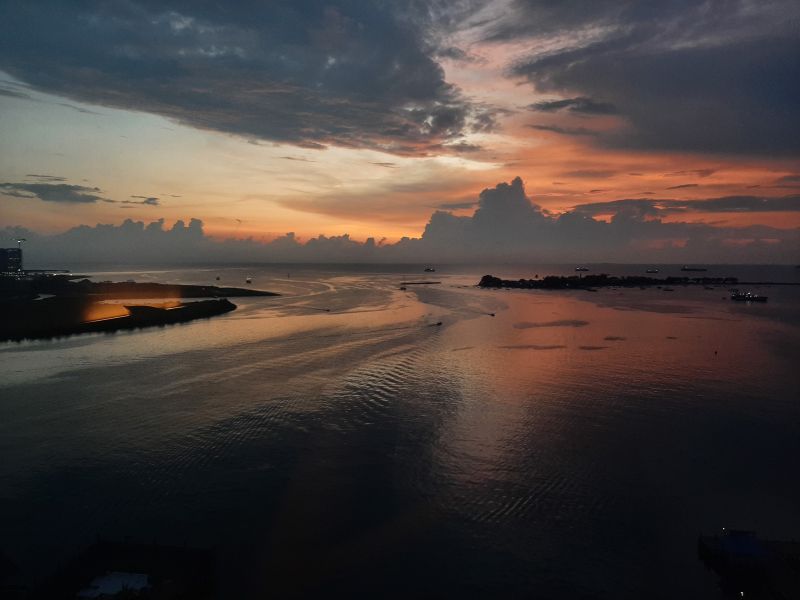
Sunset view from Belhotel on Lae-Lae.
Katt
Day 0: 0100H
Arrived in Makassar around Sunday midnight. Was tired from the >one day travel from Bremen to Makassar but was welcomed by the nice view and good food in Indonesia.
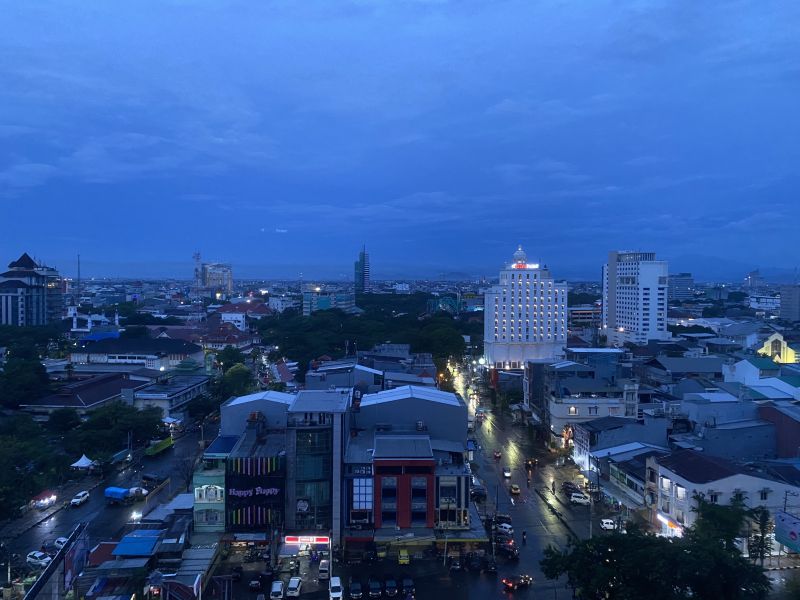
View of Makassar from the Hotel
Monday – Day 1
Mariya
Jetlag wasn’t kind to me – after no night’s sleep, I joined Katt and others in the hotel’s conference room. We finally met our colleagues from the University of Hasanuddin in person and got to know each other better through the ice-breaker activities. And let’s not forget the 4D-REEF distinguished bags for everyone ;)
On a serious note, we learned a lot about the local fisheries and their governance and the difficulties the fishermen face in their day-to-day life.
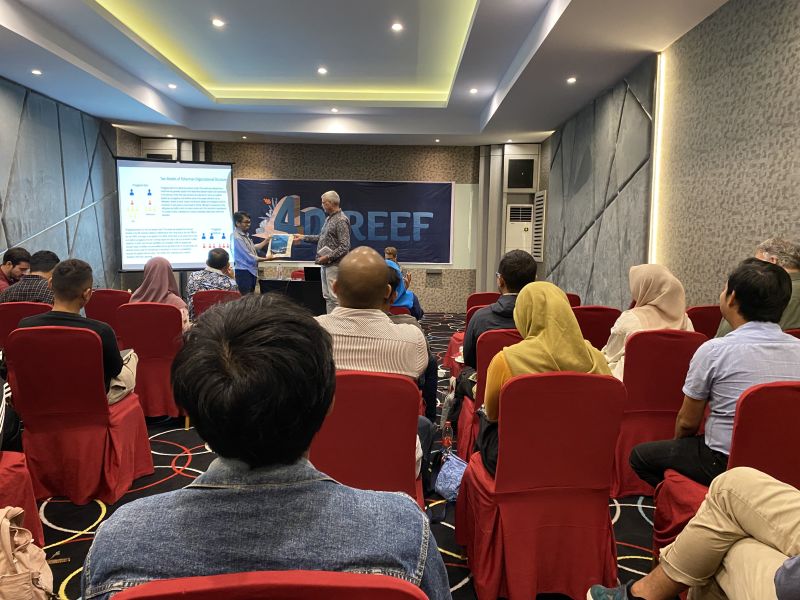
The 4D-REEF tote bag!
Katt
Day 1: 0900H
Start of the NTA program in Swiss-Belhotel in Makassar where we had a whole day of talks about coastal livelihood and fisheries in Indonesia. I was introduced to the fishing culture and social organization in Indonesia. The talks made me think how complex the fishing industry in Indonesia is and how it is tied to social relationships between various agents and institutions.
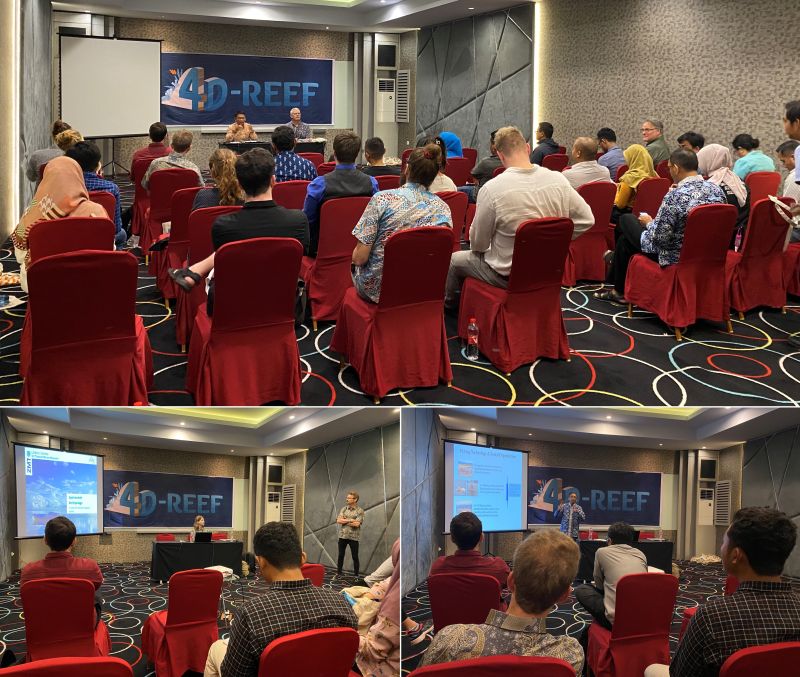
Whole day of talks on marine management and conservation, and reef restoration efforts in Indonesia. Prof. Adi Maulana (vice-rector of UNHAS University) and Dr. Willem Renema (top photo) started off the program with some welcome remarks. A series of talks followed with Dr. Sebastian Ferse (bottom left photo) giving an overview of the Spermonde archipelago social-ecological system and Dr. Dedi Adhuri (bottom right photo) talking about the fishing culture in eastern Indonesia.
Tuesday – Day 2
Mariya
We were welcomed by Prof. Jamaluddin Jompa at UNHAS, and our programme followed with a set of seminars on marine management and conservation. I was shocked and inspired at the same time by the talk of Tries Razak, PhD, on reef restoration practices. Inspired by successful ones and shocked by the destructive impacts of poorly-designed ones. All of our actions have consequences, so quality above quantity – we should remember that in our work as well.
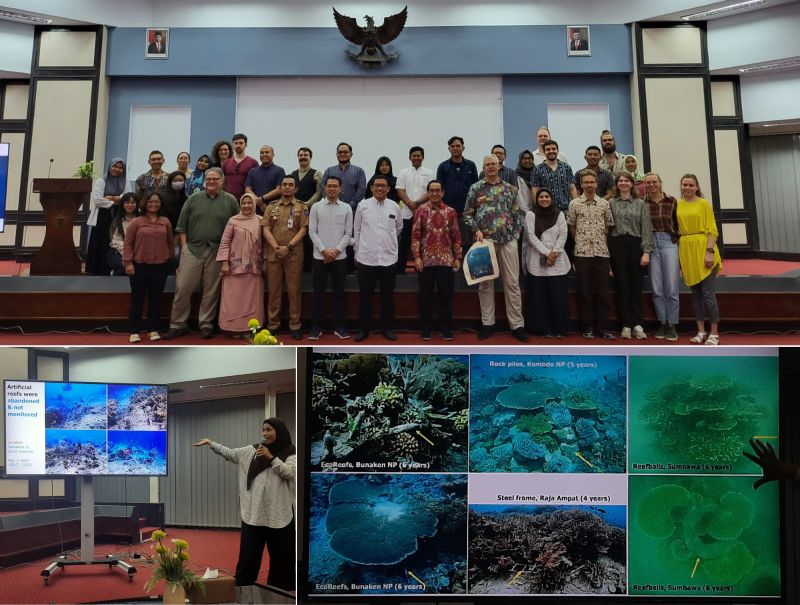
4D-REEF at UNHAS (top photo). Dr. Tries Razak giving a talk on coral reef conservation practices—the unsuccessful shown on the bottom left photo and the successful practices shown on the bottom right photo.
Katt
Day 2: 0900H
We went to Universitas Hasanuddin (UNHAS) campus for another day of talks this time on marine management and conservation as well as reef restoration efforts in Indonesia. We were welcomed by UNHAS Rector Prof. Jamaluddin Jompa and this was followed by a series of talks about the latest developments in marine research and management in Indonesia. In particular, I find the success story of the MARS project really inspiring.
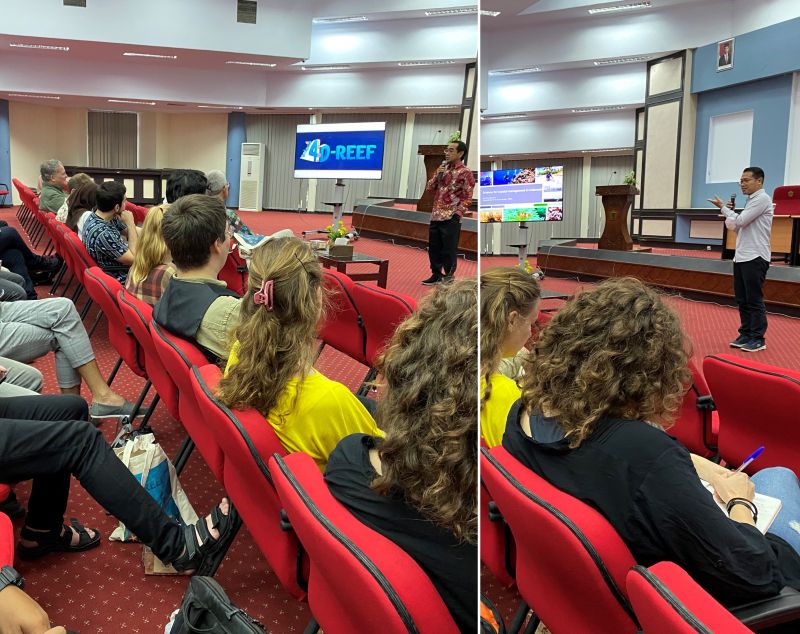
Day of talks in UNHAS. We were warmly welcomed by UNHAS Rector, Prof. Jamaluddin Jompa (left photo). Dr. Udhi Eko Hernawan, director of the Research Center for Oceanography of the National Research and Innovation Agency (BRIN) (right photo) kicked off the day’s session with his talk on science for coastal management in Indonesia.
Wednesday – Day 3
Mariya
Dream day – field day!
We started with Barrang Lompo and visited the UNHAS field station and had a walk around the island to learn about the livelihood of the island. Colourful houses, many built with sturdy massive corals, kids, riding the “daycare” bike-cart with music and fishermen, drying their catch in the hot midday sun. Some of them dried trepang – sea cucumbers – the marine animal of great value, captured from the sea bottom (a dangerous process of capture for fishermen) and sold to China. The people of Makassar traded sea cucumbers with Indigineous Australians and China since the 18th century en-masse. Sadly, because of the expensive price of sea-cucumbers, none of the local fishermen we met have ever tried even a tiny piece of the animal – all of the capture is sold overseas.
On the next islands we visited – Pulau Bonetambung and Pulao Kudingareng Lompo, we learned about the local community initiative to set up an aquaculture facility and a primary school for kids to get the basic education. Life on those further islands from Makassar city is also complicated by the shortages of fresh water, and we witnessed how locals are dealing with this issue in their households.
And I also learned a lot from the local people – big smiles, music and happiness – despite all of the hardships they have daily, they are genuinely happy, with everything the day brings to them – something we need to remind ourselves more often about!
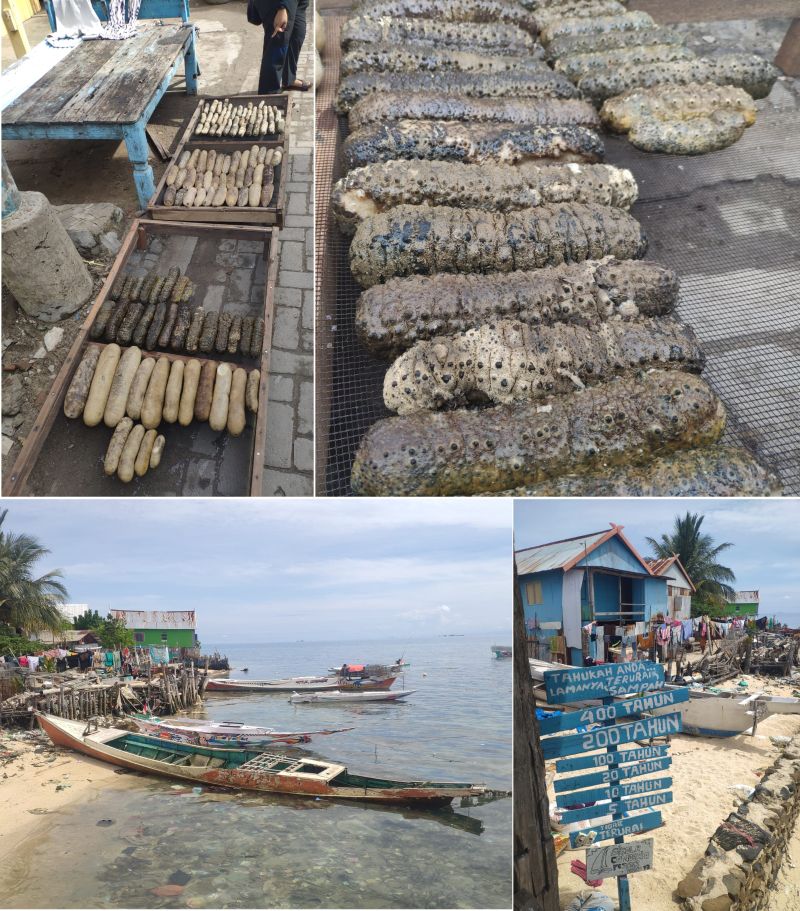
Drying of trepang – sea cucumbers (top photos, photos by Xin Ren). Pulau Bonetambung: fishing boats (bottom left) and scale of decomposition time, years, of different materials of litter (bottom right)
Katt
Day 3: 0700H
Field day! Yay! We visited select islands of the Spermonde archipelago—Barrang Lompo, Pulau Bonetambung, and Pulau Kudingarenglompo—to have a look at the coastal communities and their livelihoods on the islands. What strikes me the most is that the ones we visited are really low-lying islands and are densely populated. Also they use corals as foundations of their houses and coastal walls. We had dinner at Konro Karebosi with almost everyone. One of the best restaurants one must visit when coming to Makassar!
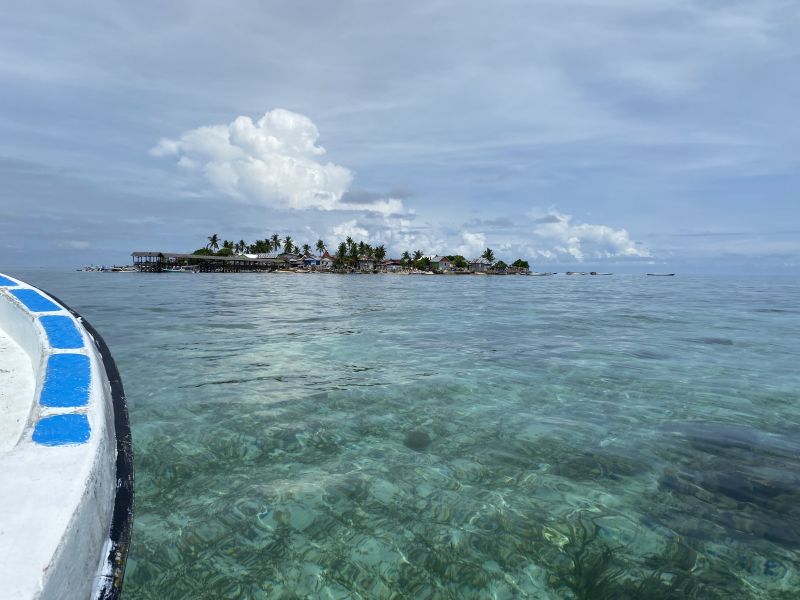
View of low-lying Bonetambung Island.
Thursday – Day 4
Mariya
Guided by Lily Damayanti and Cudo Prasetya, we witnessed HOPE of MARS coral restoration project efforts. 14m-long letters are built from hundreds of reef stars – 3D stable steel structures coated in resin and sand for creating a surface for coral attachment. Overall,coral fragments from 42 species and collected sustainably (e.g. from breakage after storms) from nearby reefs with similar environmental conditions to facilitate coral survivability and are attached to reef stars.
Also, I snorkelled for the first time ever! An exciting day, with bumps of leaking snorkel tubes :D But enjoying the day with our amazing boat crew and being rewarded by them with tasty donuts – all the efforts were worth it!
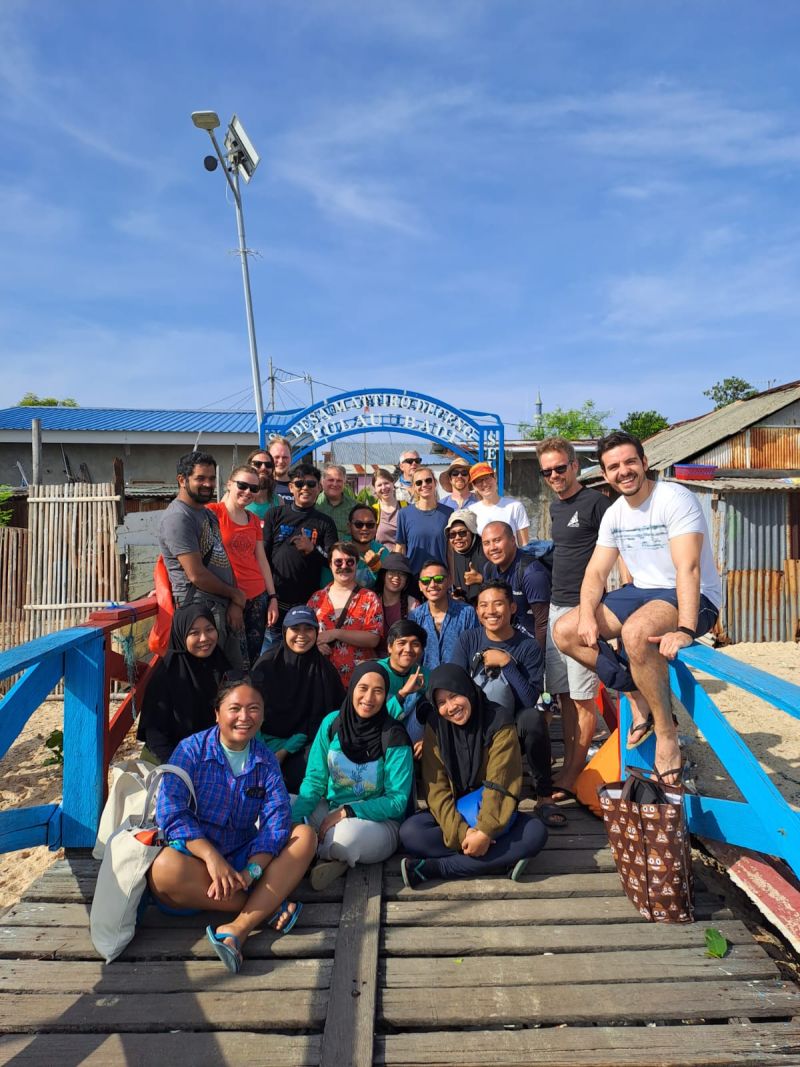 4D-REEF group photo in Pulau Badi.
4D-REEF group photo in Pulau Badi.
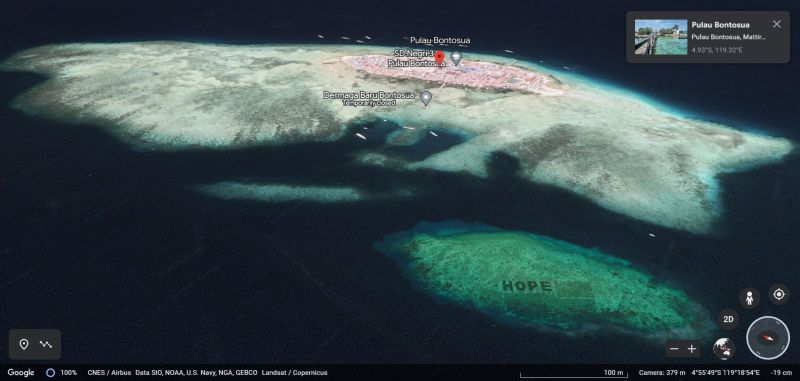 You can see HOPE from Google Earth (Google Earth).
You can see HOPE from Google Earth (Google Earth).
Katt
Day 4: 0700H
Field day: snorkeling edition. We had the great opportunity to visit the MARS restoration projects in Badi and Bontosua Islands. We went snorkeling to see HOPE (literally and figuratively) under the sea.
Try and visit Google Earth and search for this HOPE.
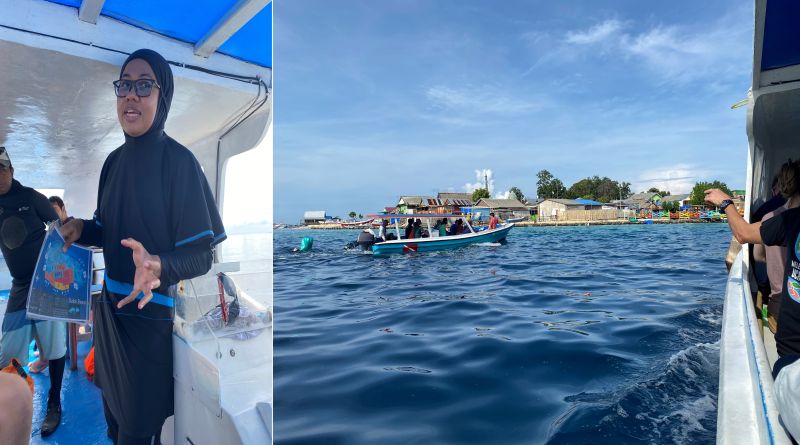
Here is Lily Damayanti, Marine Program Manager of the Mars Sustainable Solutions (MARS) project, explaining to us the location of the HOPE reef. Our boats approaching Pulau Badi.
Friday – Day 5
Mariya
We had a chance to see the University Coral Collection and talk to local scientists about the coral biodiversity and state of reefs around Makassar. The rest of the day we discussed our projects with each other and with Indonesian colleagues and looked for potential collaboration opportunities.
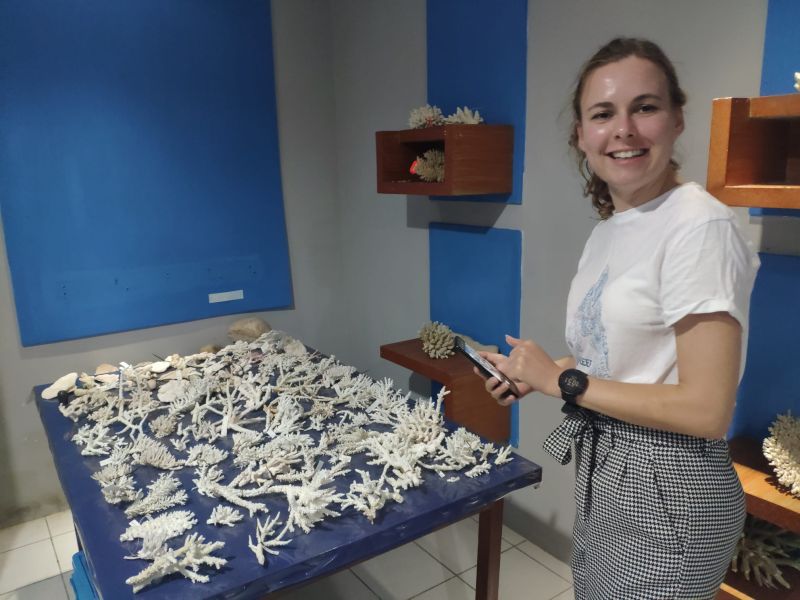
Mariya’s joy of seeing new branching coral samples in UNHAS collection
Katt
Day 5: 0730H
Back to UNHAS for one day of roundtable discussions on international research collaborations. We spent most of our time in the afternoon networking among ourselves and being updated with each and everyone’s research progress. We also spent some time working on project synthesis and collaborative work among the ESRs. We had a nice impromptu visit to the UNHAS coral museum where we saw their coral collections. Dinner (Coto Makassar) then some karaoke after.
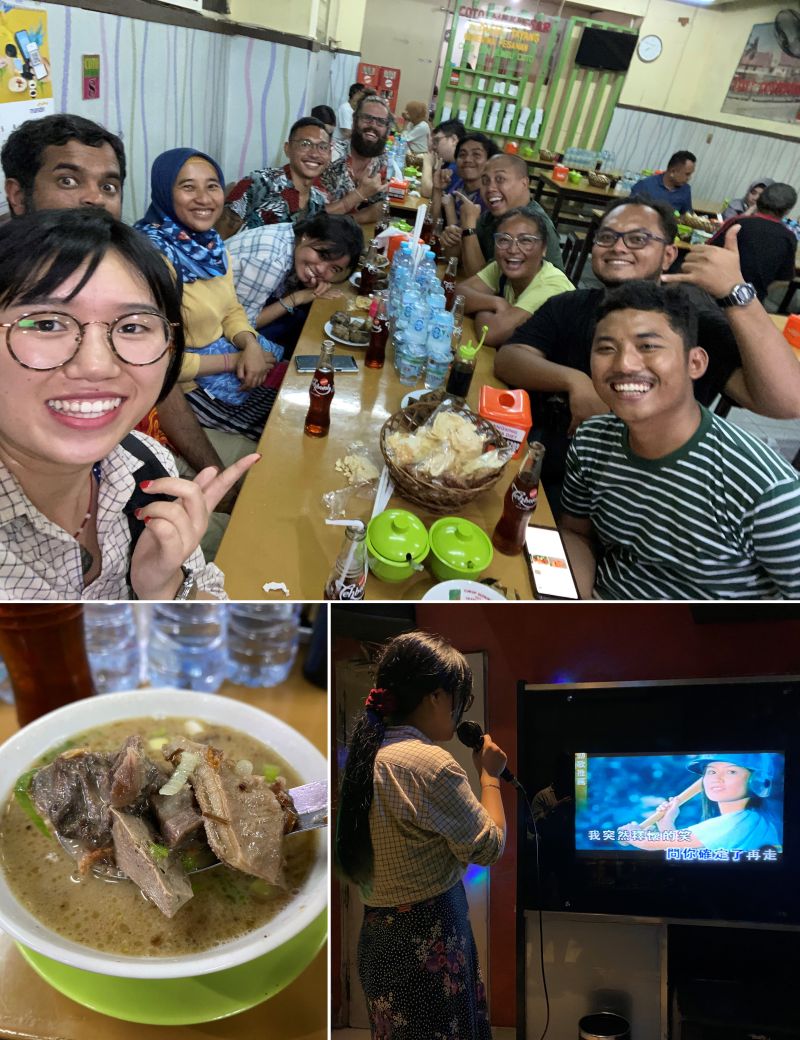
Most of the discussions were behind closed doors, so better share with you our dinner (Coto Makassar) and activity that night, karaoke!
Saturday – Day 6
Mariya
Visiting reef sites again!
Cats, cats, cats everywhere on Kodingareng Keke. And great view onto the reef structure from the observation point – you can even see the seasonal sediment dynamics patterns, change in coral cover between reef flat and slope. Also, the island has pretty interesting history of unsuccessful commercialising of the area and failed efforts of the hotel construction. All in all – no wonder it did not work – the island is very dynamic, small and has no fresh water!
Samalona island – one of the closest to the shore, turbid reef. To our surprise, the coral cover was amazing, considering a lot of it was absent some 10 years ago! In some areas of the reef, coral cover was up to 95%, so we had to be careful swimming around.
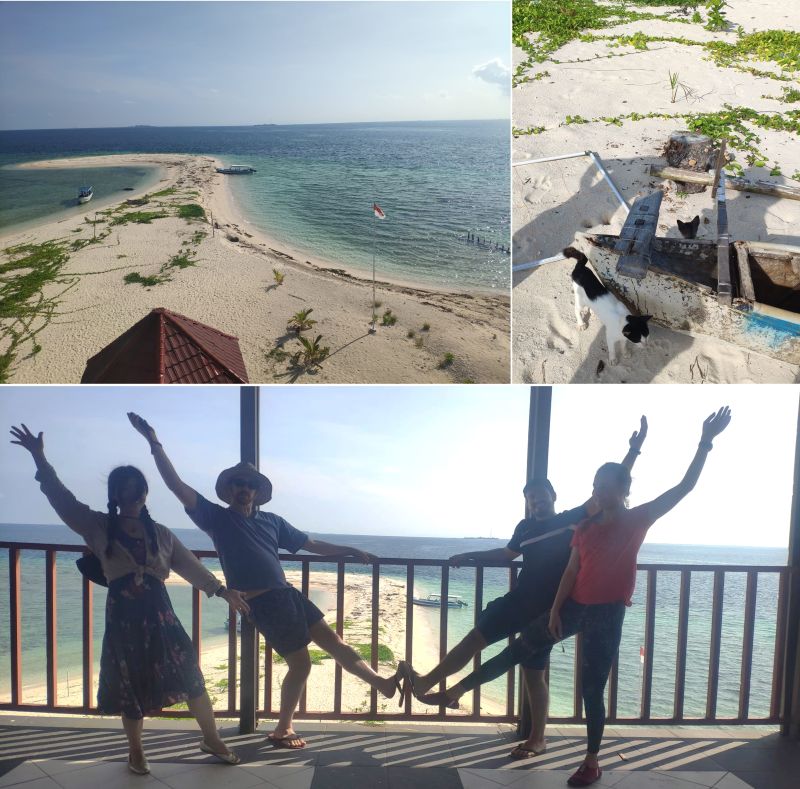
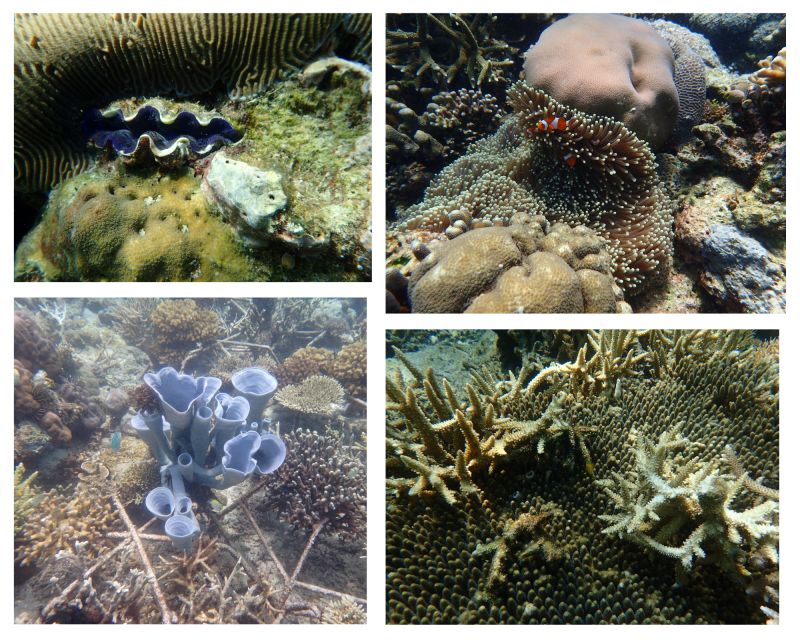
Above: Kodingareng Keke – seasonally dynamic island sediment accumulation area – and its local cats (quadrant for scale). Hi from 4D – REEF! Xin, Max, Leo, and Mariya.
Lower pictures: The beauty of the reef world. Top left – Tridacna squamosa, top right – a family of clown fish in sea anemone, surrounded by massive Porites; bottom left – sponge Haliclona sp. growing on sea star, bottom right – Acroporidae corals, branching and corymbose morphologies.
Katt
Day 6: 0700H
Field day again! This time we visited select reef sites in Samalona and Kodingareng Keke. We snorkeled and looked at the conditions of the reefs in both sites.
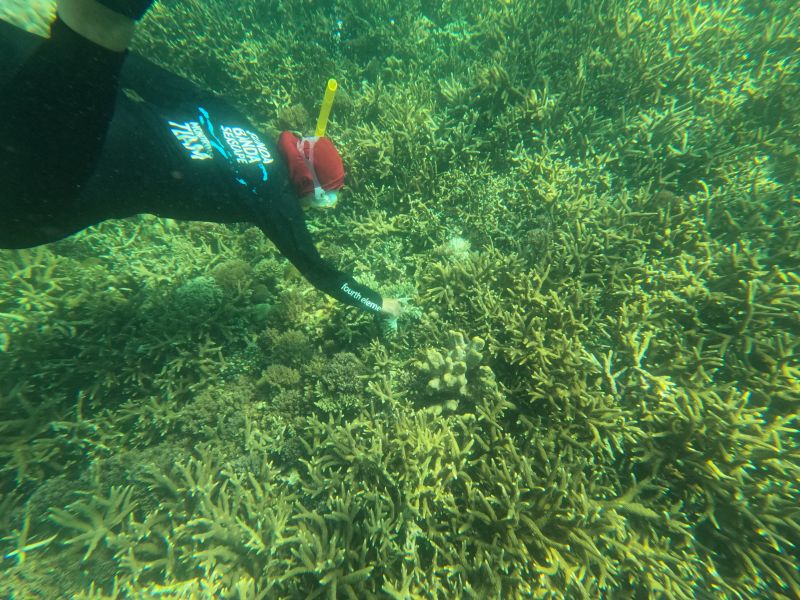
Estra checking out the condition of a coral in one of the reef sites.
Sunday – Day 7
Mariya
As for my day off – no rest for the wicked! Starting at 7am, I joined our little crew to collect some sediment samples for future composition analysis of grains with the AI, developed by our colleague, William Harrison. We returned to Kodingareng Keke for the transect sampling across the reef flat. In the areas closer to the rim it got really tricky, as there was so much coral cover that I barely could get some sand!
Things were more complicated in the degraded turbid reef site – strong current, no coral is sight and fields of sea urchins. I got deserved rest and a great recovery after swimming for so long with a relaxing massage by Indonesian masters and enjoying another tasty dinner and fruit drinks. Everyone has to try sirsak! And if you are weak to spicy food – it will save you 🙂 To continue with the first experiences – I joined guys for the evening karaoke – something I have never done before but now will definitely do again!
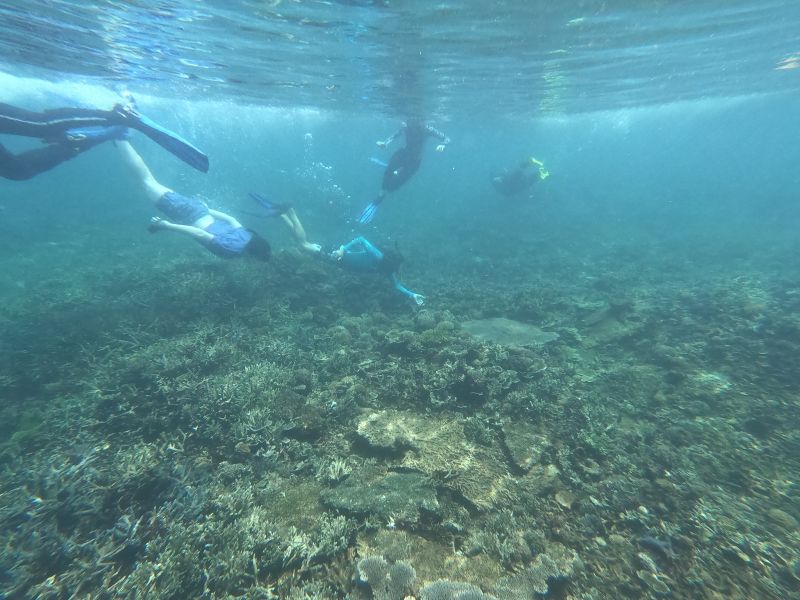
Discovering the coral diversity.
Katt
Day 7: 0600H
It was our rest day, but I decided to visit an older carbonate reef in South Sulawesi. Whole day of travel, yet I enjoyed it since I was joined by very helpful and dependable Indonesian marine researchers.
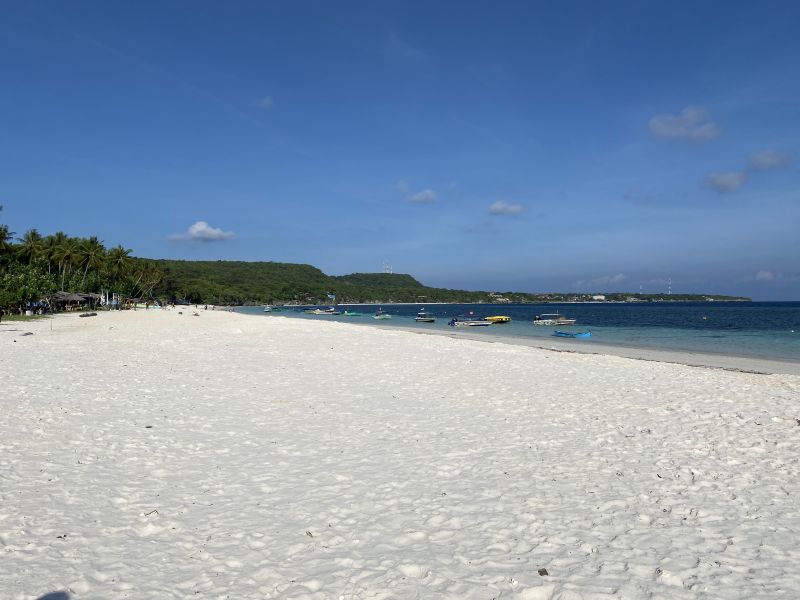
Nice view of the beach and terraces to cap off the week in South Sulawesi.
Whole-day seminars, informative presentations, chats in-between coffee breaks and lunches, long-hours of discussions, site visits on reef islands, snorkeling on different reefs, fun chats while walking, and several boat rides. Endless coconuts, hotel rooftop drinks, occasional massages, souvenir shopping, lovely food, getting soaked by rain, soaking in the pool, karaoke, and long catching-up chats.
From participating in various program-related activities to enjoying non-program-related activities, the ESRs, our Indonesian colleagues, and supervisors had a very productive NTA in Makassar.
The first week of the NTA was very insightful as we were updated about the latest state of marine research, management, and conservation efforts in Indonesia. We found it inspiring to see the MARS success story and the different marine research work in Indonesia. The marine pollution problem (which is caused by a multitude of factors like government in/action, local behavior, heavy plastic use, and many others) in the region is quite noticeable along the coastal areas and offshore islands. As part of the ESRs who were not able to join the fieldwork in Spermonde, it was nice for us to visit the reefs studied by 4D-REEF.
Next up, we’ll share some of our experiences when we flew to Bali Island for the second part of our NTA. Stay tuned.
*All photos made by 4D-Reef and ESRs.


